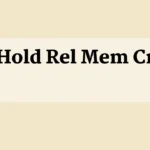Picture this: you check your Chase bank account, expecting to see your latest deposit ready to use, but instead, you spot a mysterious note—hold rel mem cr. Your heart sinks. What does it mean? Why is your money on hold? If this sounds familiar, you’re not alone. Bank holds can feel like a puzzle, but don’t worry—I’m here to break it down for you. In this guide, you’ll learn what hold rel mem cr means, why Chase places holds, and how to handle them like a pro. Let’s dive in and clear up the confusion.
Contents
What Is Hold Rel Mem Cr?

You’ve likely seen hold rel mem cr on your Chase account and wondered, What does hold rel mem cr mean for Chase? It’s a banking term that stands for Hold Release Memo Credit. This indicates a temporary hold on funds in your account, often tied to a deposit or transaction. Chase uses this to ensure the funds are valid before releasing them for your use. It’s a standard practice, but it can be frustrating if you’re caught off guard. Let’s explore the details.
Why Chase Uses Hold Rel Mem Cr
Chase places holds to protect both you and the bank. When you deposit a check, the bank needs time to verify it’s legitimate. A hold rel mem cr ensures the funds clear before you spend them. This prevents issues like bounced checks or fraud. According to Chase’s policies, holds are common for large deposits or new accounts. It’s their way of playing it safe.
Common Triggers for Holds
Several situations can spark a hold rel mem cr. Depositing a large check, especially from an unfamiliar source, is a big one. New accounts or those with low balances might also trigger holds. If you’ve had a deposited item returned Chase in the past, the bank may be extra cautious. Even ATM deposits can face delays as the bank confirms the transaction.
How Long Do Holds Last?
Hold durations vary. For most deposits, Chase releases funds within 1–2 business days. However, larger checks or accounts with a history of issues might face holds up to 7–10 days. The hold release memo credit meaning is that once verified, the funds are credited to your account. If you’re wondering, Why is there a hold on my bank account Chase?, the answer often lies in the deposit type or account status.
Real-Life Example of Hold Rel Mem Cr
In my experience, I once deposited a $5,000 check from a freelance client. The Chase app showed hold rel mem cr, and the funds were unavailable for three days. It was annoying, but calling Chase clarified the hold was due to the check’s size. They released it after verification. This is a common scenario, especially for irregular deposits.
| Deposit Type | Typical Hold Duration | Reason for Hold |
| Cash Deposit | Same day or next day | Low risk, immediate verification |
| Personal Check | 1–2 business days | Needs clearing from issuer’s bank |
| Large Check (> $5,000) | Up to 7 days | Higher fraud risk |
| Out-of-State Check | 3–5 business days | Longer verification process |
Why Is There Money on Hold in My Bank Account?
Seeing money on hold can feel like your funds are stuck in limbo. You might ask, Why is there money on hold in my bank account? Banks like Chase use holds to ensure transactions are legitimate. Let’s unpack the reasons and what you can do about it.
Fraud Prevention Measures
Banks are on high alert for fraud. A hold memo dr Chase meaning often points to a debit hold, where funds are reserved for a transaction. For example, if you deposit a check, Chase might hold the amount to avoid overdrafts if the check bounces. This protects you from unexpected fees.
Account History and Risk
Your account’s history matters. If you’re new to Chase or have had overdrafts, the bank may flag your account for holds. Reddit users on threads like hold rel mem cr Chase Bank meaning Reddit often share stories of holds due to low account balances or frequent deposits. Chase assesses risk based on your banking patterns.
Types of Transactions
Certain transactions trigger holds more than others. For instance, hold rel mem cr charges might appear for pending card transactions, like at gas stations or hotels. These holds reserve funds until the merchant finalizes the charge. Similarly, a deposited item returned Chase can lead to extended holds on future deposits.
External Factors
Sometimes, holds stem from external issues. If the check issuer’s bank is slow to respond, Chase may extend the hold. Economic factors, like high fraud rates, can also tighten bank policies. As one Redditor noted in a hold rel mem cr but funds are available Reddit thread, holds can linger even when funds seem accessible, due to processing delays.
Here’s a tip I always give beginners: Always check the deposit method. Mobile deposits often face longer holds than in-branch deposits. Knowing this can save you headaches.
| Transaction Type | Hold Trigger | Typical Resolution Time |
| Mobile Check Deposit | Verification delay | 2–5 business days |
| Pending Card Charge | Merchant processing | 1–3 days |
| Returned Check | Fraud risk | Up to 7 days |
| New Account Deposit | Risk assessment | 3–7 days |
How to Remove a Hold on Bank Account
Frustrated by a hold? You’re probably wondering, How to remove a hold on bank account? While you can’t always eliminate holds, there are steps to speed things up or avoid them. Here are practical strategies to take control.
Contact Chase Directly
The fastest way to address a hold rel mem cr is to call Chase at 1-800-935-9935. Explain the situation and ask for details. In my experience, providing proof of the deposit’s source—like a paystub—can prompt a quicker release. Be polite but firm when requesting assistance.
Visit a Branch
If phone calls don’t work, head to a Chase branch. Bring ID and any deposit-related documents. A banker can often override holds if the deposit is verified. This worked for me when a hold memo dr Chase meaning confused me on a large check deposit.
Improve Your Account Standing
Holds are less likely on established accounts. Maintain a positive balance and avoid overdrafts. Reddit discussions on hold rel mem cr Chase Bank meaning Reddit suggest that accounts over six months old face fewer holds. Regular deposits also build trust with Chase.
Choose Low-Risk Deposits
Opt for cash or direct deposits to minimize holds. Checks, especially from unknown sources, are riskier. If you must deposit a check, do it in person at a branch. This can reduce the bank hold duration compared to mobile or ATM deposits.
Monitor Your Account
Use the Chase app to track holds. If you see hold rel mem cr charges, check pending transactions. Sometimes, merchants delay finalizing charges, prolonging holds. Contacting the merchant can speed up the process. Staying proactive keeps you in the loop.
What I learned the hard way is: Never assume funds are available just because they show in your balance. Always confirm with Chase to avoid declined transactions.
| Action | How It Helps | Expected Outcome |
| Call Chase | Clarifies hold reason | Possible early release |
| Visit Branch | Direct verification | Faster hold resolution |
| Maintain Balance | Lowers risk profile | Fewer future holds |
| Use Cash Deposits | Immediate availability | No hold required |
Common Misconceptions About Bank Holds
Bank holds, like hold rel mem cr, spark confusion. Let’s clear up myths you might encounter, especially on forums like Reddit, and set the record straight.
Holds Mean Something’s Wrong
Many assume a hold signals a problem. Not true. Holds are routine for deposits or pending charges. A hold release memo credit meaning simply indicates Chase is verifying funds. It’s not a red flag unless you’re notified of an issue, like a deposited item returned Chase.
Some think held funds are untouchable. Actually, partial funds might be available. For example, Chase may release $200 of a $1,000 check while holding the rest. Check your account details to see what’s usable, as noted in hold rel mem cr but funds are available Reddit threads.
All Holds Take a Week
Hold durations vary. While some last 7 days, others clear in 1–2 days. Cash deposits often have no hold, while out-of-state checks take longer. Understanding bank hold policies helps you predict when funds will be free.
You Can’t Prevent Holds
You can’t eliminate holds entirely, but you can reduce them. Building a strong account history and choosing low-risk deposits make a difference. Knowing what does hold memo mean for banks empowers you to make smarter banking choices.
Holds Are Only for Checks
Holds aren’t just for checks. Pending card transactions, like hotel bookings, can trigger hold rel mem cr charges. These reserve funds until the merchant settles the bill, often within days. Being aware of transaction hold reasons prevents surprises.
5 Actionable Tips to Manage Bank Holds
Struggling with hold rel mem cr? Here are five actionable tips to navigate holds and keep your finances on track:
- Call Chase Immediately: Contact Chase at 1-800-935-9935 as soon as you see a hold. Ask for specifics and request an early release if possible.
- Deposit In-Branch: Avoid mobile or ATM deposits for large checks. In-person deposits often clear faster, reducing hold times.
- Track Transactions: Use the Chase app to monitor pending charges or holds. This helps you spot issues early and plan accordingly.
- Build Account Trust: Maintain a positive balance and regular deposits. Older accounts with good standing face fewer holds.
- Ask Merchants to Finalize Charges: For pending card holds, contact the merchant to settle the transaction quickly, releasing reserved funds.
FAQs About Hold Rel Mem Cr
What does hold rel mem cr mean for Chase?
It’s a temporary hold on funds, often for deposits or pending transactions. Chase uses it to verify legitimacy before releasing the money.
Why is there a hold on my bank account Chase?
Holds occur to prevent fraud, verify deposits, or reserve funds for pending charges. Large checks or new accounts often trigger them.
How long does a hold rel mem cr last?
Most holds clear in 1–2 business days, but large or risky deposits can take up to 7–10 days, depending on Chase’s verification.
Can I remove a hold on my bank account?
You can’t always remove holds, but calling Chase or visiting a branch with proof of deposit can speed up the release process.
Why do I see hold rel mem cr charges?
These are often pending card transactions, like at gas stations or hotels, where funds are reserved until the merchant finalizes the charge.
What if my deposited item is returned Chase?
If a check bounces, Chase may place longer holds on future deposits. Contact the issuer to resolve issues and clear the hold.
Read More: Muke AI: Boost Your Content Strategy
Conclusion
Navigating a hold rel mem cr on your Chase account can feel like a hassle, but it’s a standard banking practice to keep your money safe. By understanding what does hold rel mem cr mean for Chase and why holds happen, you’re better equipped to manage them. Whether it’s calling Chase, choosing low-risk deposits, or tracking transactions, you have the power to minimize disruptions. Use the tips and insights here to stay in control of your finances. Next time you see a hold, you’ll know exactly what to do.

Sarah Wilson is a skilled writer who works in many different areas. She creates interesting and helpful content, sharing useful information and keeping readers engaged with her knowledge and love for a wide range of topics.











